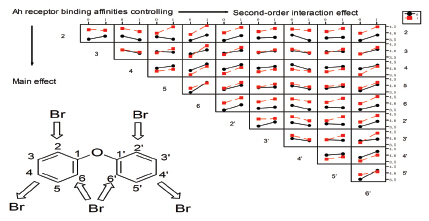[1] Erickson, P.R.; Grandbois, M.; Arnold, W.A.; McNeill, K.Environ.Sci.Technol.2012, 46, 8174.
[2] Labunska, I.; Harrad, S.; Santillo, D.; Johnston, P.; Brigden, K.Environ.Sci.: Processes Impacts 2013, 15, 503.
[3] Cao, H.J.; He, M.X.; Han, D.D.; Sun, Y.H.; Xie, J.Atmos.Environ.2011, 45, 1525.
[4] Su, G.Y.; Yu, Y.J.; Liu, H.L.; Yu, H.X.Chinese J.Anal.Chem.2013, 41, 754.(苏冠勇, 余益君, 刘红玲, 于红霞, 分析化学, 2013, 41, 754.)
[5] Wang, Z.Y.; Zhai, Z.C.; Wang, L.S.; Chen, J.L.; Kikuchi, O.; Watanabe, T.J.Mol.Struct.: Theochem 2004, 672, 97.
[6] Na, S.; Kim, M.; Paek, O.; Kim, Y.Chemosphere 2013, 90, 1736.
[7] Wahl, M.; Lahni, B.; Guenther, R.; Kuch, B.; Yang, L.; Straehle, U.; Strack, S.; Weiss, C.Chemosphere 2008, 73(2), 209.
[8] Lilienthal, H.; Hack, A.; Roth-Harer, A.; Grande, S.W.; Talsness, C.E.Environ.Health Persp.2006, 114, 194.
[9] Gu, Y.Z.; Hogenesch, J.B.; Bradfield, C.A.Ann.Rev.Pharmacol.Toxicol.2000, 40, 519.
[10] Denison, M.S.; Pandini, A.; Nagy, S.R.; Baldwin, E.P.; Bonati, L.Chem.Biol.Interact.2002, 141, 3.
[11] Safe, S.H.Crit.Rex.Toxicol.1990, 21, 51.
[12] Kovarich, S.; Papa, E.; Gramatica, P.J.Hazard.Mater.2011, 190, 106.
[13] Chen, G.S.; Konstantinov, A.D.; Chittim, B.G.; Joyce, E.M.; Bols, N.C.; Bunce, N.J.Environ.Sci.Technol.2001, 35, 3749.
[14] Wang, Y.W.; Liu, H.X.; Zhao, C.Y.; Liu, H.X.; Cai, Z.W.; Jiang, G.B.Environ.Sci.Technol.2005, 39, 4961.
[15] Gu, C.G.; Ju, X.H.; Jiang, X.; Yu, K.; Yang, S.G.; Sun, C.Ecotox.Environ.Safe.2010, 73, 1470.
[16] Zheng, G.; Xiao, M.; Lu, X.H.QSAR Comb.Sci.2007, 26, 536.
[17] Xu, H.Y.; Zou, J.W.; Yu, Q.S.; Wang, Y.H.; Zhang, J.Y.; Jin, H.S.Chemosphere 2007, 66, 1998.
[18] Papa, E.; Kovarich, S.; Gramaticam, P.Chem.Res.Toxicol.2010, 23, 946.
[19] Gu, C.G.; Ju, X.H.; Jiang, X.; Wang, F.; Yang, S.G.; Sun, C.SAR QSAR Environ.Res.2009, 20, 287.
[20] Wang, Y.W.; Zhao, C.Y.; Ma, W.P.; Liu, H.X.; Wang, T.; Jiang, G.B.Chemosphere 2006, 64, 515.
[21] Gu, C.G.; Goodarzi, M.; Yang, X.L.; Bian, Y.R.; Cheng, S.; Xin, J.Toxicol.Lett.2012, 208, 269.
[22] Luthe, G.; Jacobus, J.A.; Robertson, L.W.Environ.Toxicol.Pharmacol.2008, 25, 202.
[23] Long, J.Y.; Yi, H.B.; Liu, X.K.; Wang, Y.F.Acta Chim.Sinica 2012, 70, 949.(龙杰义, 易海波, 刘星楷, 汪易飞, 化学学报, 2012, 70, 949.)
[24] Li, Y.; Wang, M.; Zhang, C.; Gao, Q.J.Jilin Univ.2013, 43, 1595.(李鱼, 王檬, 张琛, 高茜, 吉林大学学报, 2013, 43, 1595.)
[25] Cheng, Y.Y.; Chen, M.J.; Wu, Y.J.Acta Chim.Sinica 2002, 60, 2017.(程翼宇, 陈闽军, 吴永江, 化学学报, 2002, 60, 2017.)
[26] Li, Y.; Jiang, L.; Li, X.L.; Hu, Y.; Wen, J.Y.Chem.Res.Chin.Univ.2013, 29, 568.
[27] Gramatica, P.QSAR Comb.Sci.2007, 26, 694.
[28] OECD(Organisation for Economic Co-Operation and Development).Guideline document on the validation of (quantitative) structure-activity relationship [(Q)SAR] models.ENV/JM/MONO(2007)2, 2007.


